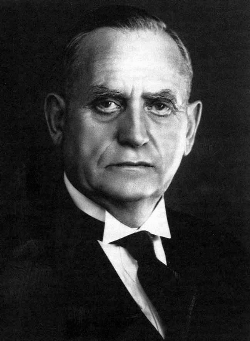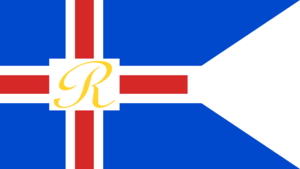Sveinn Björnsson facts for kids
Quick facts for kids
Sveinn Björnsson
|
|
|---|---|

Sveinn Björnsson
|
|
| 1st President of Iceland | |
| In office 17 June 1944 – 25 January 1952 |
|
| Prime Minister | Björn Þórðarson Ólafur Thors Stefán Jóhann Stefánsson Steingrímur Steinþórsson |
| Preceded by | Christian X (as King of Iceland) |
| Succeeded by | Ásgeir Ásgeirsson |
| Regent of Iceland | |
| In office 15 May 1941 – 17 June 1944 |
|
| Monarch | Kristján X |
| Preceded by | Position created |
| Succeeded by | Position abolished |
| Personal details | |
| Born | 27 February 1881 Copenhagen, Denmark |
| Died | 25 January 1952 (aged 70) Reykjavík, Iceland |
| Nationality | Icelandic |
| Spouse | Georgia Björnsson |
| Children | 6, including his eldest son Björn Sveinsson Björnsson |
| Alma mater | University of Copenhagen |
| Profession | Lawyer |
Sveinn Björnsson (born February 27, 1881 – died January 25, 1952) was a very important person in Icelandic history. He became the first president of Iceland in 1944 and served until 1952. Before that, he was the Regent of Iceland during World War II.
Contents
Early Life and Education
Sveinn was born in Copenhagen, Denmark. His father, Björn Jónsson, was an editor and later a government minister. Sveinn finished high school at the Latin School in Reykjavík in 1900.
He then went on to study law at the University of Copenhagen and earned his law degree in 1907. After that, he worked as a lawyer and a public prosecutor in Reykjavík for many years. A public prosecutor is a lawyer who works for the government and tries to prove that someone has broken the law.
Political Beginnings and Diplomacy
Sveinn started his political career in the Reykjavík City Council, where he was a member from 1912 to 1920. He was also the chairman of the council for some of those years.
He was elected to the Althing, which is Iceland's parliament, representing Reykjavík in 1914-1915 and again in 1919-1920. After Iceland became an independent country from Denmark in 1918, Sveinn served as Iceland's representative (like an ambassador) to Denmark. He held this important diplomatic role from 1920 to 1924 and again from 1926 to 1940.
Becoming Regent of Iceland
Even though Iceland became a sovereign state in 1918, Denmark still handled its foreign affairs. This changed when World War II began. In April 1940, Germany occupied Denmark. This meant that the Danish King, Christian X, who was also the King of Iceland, could no longer perform his duties for Iceland.
Because of this, Sveinn was chosen to be the Regent of Iceland. A regent is someone who governs a country when the king or queen cannot. Sveinn was elected Regent three times between 1941 and 1943. He took on all the powers that the King used to have in Iceland.
In July 1941, United States troops came to Iceland at the invitation of Sveinn's government. They stayed in Iceland even after the war ended, which was a big topic of discussion in Iceland's foreign policy.
First President of Iceland
In 1944, Iceland officially became a republic, meaning it would have a president instead of a king. Sveinn was elected as the first president by the Althing. His first term was only one year because the people of Iceland were going to vote directly for their president for the first time in 1945.
Sveinn was re-elected as president in 1945 and 1949 without anyone running against him. He was very careful to follow all the correct rules for a head of state. He even asked Icelandic embassies to send him books on how diplomats should act.
After the 1949 parliamentary elections, when political parties were struggling to form a new government, Sveinn said he would form one himself if they couldn't agree within four months. He believed the constitution gave him this power. However, some historians, like later president Guðni Th. Jóhannesson, have disagreed with this interpretation.
Sveinn's relationship with the Danish King, Christian X, became difficult after Iceland became a republic. The King felt that Iceland had broken a promise to return to normal relations after the war, which Sveinn denied. Because of this, Sveinn did not make an official visit to Denmark as president. King Christian X died in 1947. Sveinn himself had poor health later in his presidency and could not visit Denmark.
Iceland joined NATO on March 30, 1949. This decision caused some protests and disagreements within the country. On May 5, 1951, Iceland signed a defense agreement with the United States. American troops, known as the Iceland Defence Force, returned to Iceland and stayed throughout the Cold War. The last of these forces left in 2006.
Sveinn died in Reykjavík in January 1952, before his third term was finished. He is the only president of Iceland to have died while still in office. He had been in poor health since 1949.
Other Activities and Family Life
Sveinn was involved in many businesses and organizations. He helped start Eimskipafélag Íslands, a major shipping company in Iceland, in 1914 and was its chairman for several years. He also founded and directed insurance companies like Brunabótafélag Íslands (Icelandic Fire Insurance Company) and Sjóvátryggingafélag Íslands (Icelandic Maritime Insurance Company).
He was also one of the people who helped create the Icelandic Red Cross on December 10, 1924, and was its first chairman.
Sveinn married Georgia Björnsson in 1908. They had six children together. Their eldest son, Björn Sveinsson Björnsson, served in the German military during World War II.
Sveinn's granddaughter, Brynhildur Georgía Björnsson, is the main character in a historical novel called The Woman at 1000°. This book talks a lot about Sveinn and his family. His great-grandson, Henrik Björnsson, is a singer and guitarist in the band Singapore Sling. His great-granddaughter, Georgía Olga Kristiansen, made history as the first female referee to work in Iceland's top men's basketball league.
Images for kids
See also
 In Spanish: Sveinn Björnsson para niños
In Spanish: Sveinn Björnsson para niños



